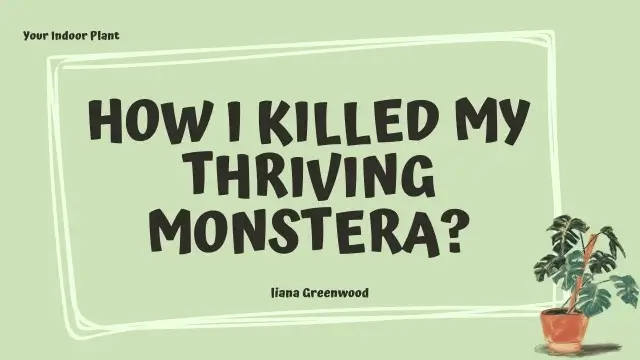7 Common Monstera Plant Mistakes (And How to Fix Them)

Mistakes happen — even to seasoned Monstera lovers like me. 🌿
When I brought home my first Monstera deliciosa, I made almost every rookie error: overwatering, low light, you name it. But each slip was a chance to learn what this stunning plant really needs.
In this guide, I’ll walk you through 7 of the most common Monstera mistakes I’ve seen (and made!) — and how to fix them, fast.
The most common Monstera care mistakes are overwatering, low light, poor soil, and neglecting pruning. These issues can lead to yellow leaves, slow growth, or root rot — but they’re all fixable with the right care routine.
1. Overwatering in a Pot That’s Way Too Big
I used to think giving my Monstera more space was a good thing, so I planted it in a large decorative pot.
But guess what? That oversized pot held too much moisture, and the roots started to rot.
Lesson learned: choose a pot that’s just slightly bigger than the root ball, always with proper drainage holes. And water only when the top few inches of soil are dry.
2. Picking Pots Based on Looks (Not Function)
Let’s be honest—I’ve definitely picked a pot because it looked cute, not because it was right for the plant. Some pots may be beautiful but trap moisture, or worse, lack drainage.
Now I keep my Monstera in a breathable nursery pot tucked inside a prettier cachepot. It’s functional and still looks good!
3. Repotting in Winter Just Because It “Looks Healthy”
One winter, I repotted my Monstera just because it seemed happy and I was in the mood to refresh things. Big mistake. It stopped growing and looked stressed for weeks.
Now I only repot in spring or early summer when the plant is actively growing and can bounce back quickly.
4. Underestimating Its Need for Bright, Indirect Light
I once placed my Monstera near a north-facing window, thinking it was “bright enough.” But the leaves stayed small and lacked those beautiful fenestrations (the holes and splits).
When I moved it closer to a bright, south-facing window with filtered light, everything changed—bigger leaves, faster growth, and deeper green color.
5. Trying to “Help” the Leaves Unfurl
It’s tempting, right? A new leaf is stuck, and you just want to help it open.
I used to gently tug or mist obsessively. But this often caused tears or damage.
Now, I boost humidity and let the plant do its thing. Patience always wins with Monsteras.
6. Wiping the Leaves Too Often
Of course, clean leaves help with photosynthesis. But I used to wipe mine every few days out of habit. That led to some dullness and even light scarring.
These days, I clean them once or twice a month with a damp cloth (no leaf shine), and they stay healthy and glossy without overhandling.
7. Mistaking Yellow Leaves for a Watering Problem (Every Time)
Not all yellowing means overwatering—sometimes it’s natural aging, root-bound stress, or even a lack of nutrients.
I used to panic and adjust watering every time a leaf turned yellow.
Now, I check soil moisture, root health, and feeding schedule before jumping to conclusions.
Bonus Tip: Skipping the Root Check Before Repotting
One of the sneakiest mistakes I made? Repotting without checking the roots first. Just because your Monstera looks big on top doesn’t mean it’s root-bound underneath.
I once moved mine to a larger pot way too soon — only to discover the roots were barely touching the edge of the current one!
Now, I gently lift the root ball to peek at what’s going on. If the roots are circling tightly or poking through the drainage holes, it’s ready for a new home. If not, I leave it be — and my plant thanks me for the patience.
FAQs
-
Why are my Monstera leaves turning yellow?
Yellow leaves aren’t always from overwatering! They can also mean your plant is root-bound, underfed, or just letting go of older growth. Always check soil moisture, pot size, and your feeding routine before reacting.
-
Should I mist my Monstera every day?
Nope, daily misting isn’t necessary — and can even cause fungal issues if done too much. Instead, aim for consistent room humidity (around 60%). I use a humidifier in dry months and only mist when a new leaf is unfurling.
-
Why isn’t my Monstera getting splits or holes in the leaves?
Lack of fenestrations usually means the plant isn’t getting enough bright, indirect light. Once I moved mine closer to a bright window (with a sheer curtain), the next few leaves came out bigger and beautifully split.
-
Can I put my Monstera outside in summer?
Absolutely — but do it gently. Transition your plant to outdoor conditions slowly, and always keep it in shade or filtered light to avoid sunburn. I move mine to a covered porch when nighttime temps stay above 60°F (16°C).
-
How often should I clean my Monstera’s leaves?
About once or twice a month is perfect. Wipe with a damp microfiber cloth to remove dust and help it breathe. Avoid harsh products or frequent rubbing — it can damage the surface over time.
Conclusion
If you’ve ever lost a Monstera because of a small mistake, you’re not alone. We all learn through trial and error — and that’s what makes the journey so rewarding.
For me, the biggest lesson was realizing that great Monstera care isn’t about doing more. It’s about knowing when to step back. Trusting the plant. Giving it room to grow, even if that means resisting the urge to repot or over-love it.
If you’re just starting out, let this guide help you avoid the most common Monstera mistakes — like repotting in winter, using oversized pots, or constantly shifting leaves. These small habits can make a big difference in how your Monstera thrives.
Want more Monstera care tips? Explore our full guide to Monstera plant care or learn why your swiss cheese plant wilting. Your future Monstera will thank you. 🌱
